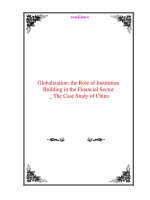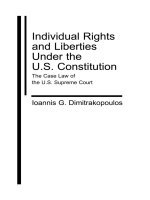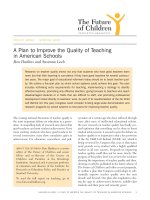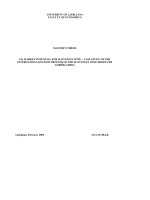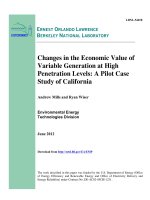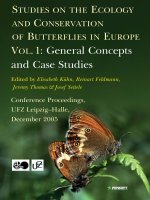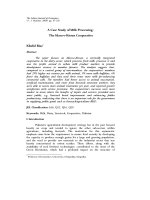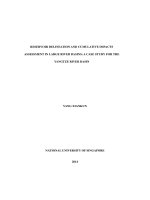- Trang chủ >>
- Cao đẳng - Đại học >>
- Luật
The WTO Case Law of 2001 The American Law Institute Reporters 039 Studies The American Law Institute Reporters Studies on WTO Law
Bạn đang xem bản rút gọn của tài liệu. Xem và tải ngay bản đầy đủ của tài liệu tại đây (1.88 MB, 325 trang )
This page intentionally left blank
THE WTO CASE LAW OF 2001
THE AMERICAN LAW INSTITUTE
REPORTERS’ STUDIES
This book is the first in a new series of annual volumes that will be utilized in the development of an American Law Institute (ALI) project on
World Trade Organization Law. The project will undertake yearly analysis
of the case law from the adjudicating bodies of the WTO. The Reporters’
Studies for 2001 cover a wide range of WTO law ranging from classic trade
in goods issues to intellectual property protection. Each of the cases is
jointly evaluated by an economist and a lawyer, both well-known experts
in the field of trade law or international economics. The Reporters critically review the jurisprudence of WTO adjudicating bodies and attempt
to evaluate whether the ruling “makes sense” from an economic as well as
a legal point of view, and, if not, whether the problem lies in the interpretation of the law or the law itself. The Studies do not always cover all issues
discussed in a case, but they seek to discuss both the procedural and the
substantive issues that form the “core” of the dispute.
henrik horn is Professor of International Economics and Deputy
Director at the Institute for International Economic Studies, Stockholm
University. He has previously worked for the Economic Research and
Analysis Division of the World Trade Organization, and has been a judge
in the Swedish Market Court (supreme court for competition cases). He
is a member of the Editorial Board of the World Trade Review and is a
research fellow at the Centre for Economic Policy Research (CEPR).
petros c. mavroidis is Professor of Law at the University of Neuchˆatel
and Columbia Law School. He was previously Chair of Competition Law,
European University Institute, Florence and a member of both the Legal
Affairs Division of the World Trade Organization and the Centre for
Economic Policy Research (CEPR). He is Associate Editor of the Journal
of World Trade and a member of the Editorial Board of the World Trade
Review, Columbia Journal of Transnational Law, and Columbia Journal of
European Law.
THE WTO CASE LAW OF 2001
The American Law Institute
Reporters’ Studies
Edited by
HENRIK HORN AND PETROS C. MAVROIDIS
cambridge university press
Cambridge, New York, Melbourne, Madrid, Cape Town, Singapore, São Paulo
Cambridge University Press
The Edinburgh Building, Cambridge cb2 2ru, UK
Published in the United States of America by Cambridge University Press, New York
www.cambridge.org
Information on this title: www.cambridge.org/9780521834216
© The American Law Institute, 2003
This publication is in copyright. Subject to statutory exception and to the provision of
relevant collective licensing agreements, no reproduction of any part may take place
without the written permission of Cambridge University Press.
First published in print format 2004
isbn-13
isbn-10
978-0-511-26635-5 eBook (EBL)
0-511-26635-9 eBook (EBL)
isbn-13
isbn-10
978-0-521-83421-6 hardback
0-521-83421-X hardback
Cambridge University Press has no responsibility for the persistence or accuracy of urls
for external or third-party internet websites referred to in this publication, and does not
guarantee that any content on such websites is, or will remain, accurate or appropriate.
CONTENTS
Foreword
List of reporters
page vii
x
1
Introduction
1
Henrik Horn and Petros C. Mavroidis
2
EC – Asbestos
European Communities – Measures Affecting
Asbestos and Asbestos-Containing Products
Henrik Horn and Joseph H. H. Weiler
14
3
US – Shrimp
United States – Import Prohibition of Certain Shrimp
and Shrimp Products, Recourse to Article 21.5 of the
DSU by Malaysia
41
Robert Howse and Damien J. Neven
4
US – Lamb
United States – Safeguard Measures on Imports of
Fresh, Chilled or Frozen Lamb Meat from New
Zealand and Australia: What Should Be Required of a
Safeguard Investigation?
72
Henrik Horn and Petros C. Mavroidis
5
EC – Bed Linen
European Communities – Anti-Dumping
Duties on Imports of Cotton-Type Bed Linen
from India
115
Merit E. Janow and Robert W. Staiger
6
Mexico – Corn Syrup
Mexico – Anti-Dumping Investigation of High
Fructose Corn Syrup from the United States,
v
vi
contents
Recourse to Article 21.5 of the DSU by the United
States
140
Robert Howse and Damien J. Neven
7
Argentina – Ceramic Tiles
Argentina – Definitive Anti-Dumping Measures on
Imports of Ceramic Floor Tiles from Italy
155
Robert Howse and Damien J. Neven
8
US – Lead and Bismuth II
United States – Imposition of Countervailing Duties
on Certain Hot-Rolled Lead and Bismuth Carbon
Steel Products Originating in the United Kingdom:
Here Today, Gone Tomorrow? Privatization and the
Injury Caused by Non-Recurring Subsidies
170
Gene M. Grossman and Petros C. Mavroidis
9
US – Export Restraints
United States – Measures Treating Export Restraints as
Subsidies
201
Merit E. Janow and Robert W. Staiger
10
Canada – Dairy
Canada – Measures Affecting the Importation of
Dairy Products and the Exportation of Milk
236
Merit E. Janow and Robert W. Staiger
11
US – Section 110(5) Copyright Act
US – Section 110(5) of the US Copyright Act,
Recourse to Arbitration under Article 25 of the DSU:
Would’ve or Should’ve? Impaired Benefits due to
Copyright Infringement
281
Gene M. Grossman and Petros C. Mavroidis
Index
300
FOREWORD
Since 1923, the American Law Institute (ALI) has sought to “restate”
American law. This means seeking coherent and progressive doctrine in
the confusion of common-law decisions by judges. Note that unlike countries with a unified legal system, the United States has fifty states, each
with its own rules as to many areas of public and private law. The ALI, a
private organization, is a primary source of legal unification.
The Institute has also worked on reforming other areas of law, for example criminal law and tax law. And in recent years it has sought to be helpful
internationally, for example in the project on Transnational Civil Procedure, cosponsored with Unidroit, and in its attempt to assist coordination
of transnational bankruptcies in Canada, Mexico, and the United States.
Aside, however, from a chapter in our Restatement Third, the Foreign
Relations Law of the United States, which antedated the present World
Trade Organization regime, the current project represents the Institute’s
first effort to engage with trade law.
The law of international trade is at an early stage of development.
Trade, of course, is old, and so are bilateral and some multilateral attempts
to establish rules. But the World Trade Organization (WTO), with its
elaborate dispute-resolution system, is only nine years old, and so far there
have been fewer than sixty decisions by the Appellate Body. Attempting
to describe rules of trade law is like authoring a treatise on contract law in
England in the year 1200, when the King’s Bench had rendered a similarly
modest number of opinions.
Nonetheless, the effort to build legal principles on the framework of
the WTO decisions seems worthwhile. If talented economists and lawyers
analyze the decisions, those engaged in the process can be drawn into
conversation and over time there will be agreement on basic concepts.
This will not happen quickly, but the significance for the world economy
is great and assisting the effort, even modestly, will be valuable.
This project, whose working title is Principles of Trade Law: The World
Trade Organization, is new for the ALI in two ways. First, each portion of
vii
viii
foreword
the work is being undertaken by both a lawyer and an economist. Second,
the two leaders of the project, Henrik Horn of Stockholm University
and Petros Mavroidis of the University of Neuchˆatel and Columbia Law
School, are not Americans. The two Chief Reporters selected three other
lawyer/economist teams and the four teams each analyzed a group of
2001 decisions by the adjudicating bodies of the WTO. Those analyses
were themselves subjected to critical analysis by the other Reporters at a
meeting in October and then by an international group of experts on the
law and economics of the world trading system at a two-day invitational
conference in February. The resulting set of Reporters’ Studies is included
in this volume.
As I write, the team of scholars, to which another lawyer and economist
have been added, has begun work analyzing the decisions rendered by the
WTO in 2002. Our plan is to carry out this “bottom–up” process of analyzing individual trade law decisions for several more years, and only then
to attempt to draft general principles based on the analysis of the individual disputes. It should be noted that this preliminary series of Reporters’
Studies, of which the present volume represents the first installment, is
the work of the participating Reporters themselves rather than of the
American Law Institute. We envision these Studies, of tremendous value
and importance in their own right, as constituting the essential matrix for
developing the broader formulations that we hope eventually to be able
to issue under the aegis of the Institute itself.
We are immensely grateful to our Reporters and to those who have
criticized the earlier drafts of their work. We are also grateful for the financial support that has made this project possible from Jan Wallander’s
and Tom Hedelius’ Research Foundation, Svenska Handelsbanken,
Stockholm, from the Asia-Pacific Economic Cooperation Study Center
at Columbia University, and from the Milton and Miriam Handler
Foundation.
This is challenging work, but we begin the undertaking confident that
our efforts can assist in a small way in the creation of a peaceful and
prosperous world.
Lance Liebman
Director
The American Law Institute
A note on the American Law Institute
The American Law Institute was founded in 1923 and is based in Philadelphia. The Institute, through a careful and deliberative process, drafts and
then publishes various restatements of the law, model codes, and other
proposals for legal reform “to promote the clarification and simplification
of the law and its better adaptation to social needs, to secure the better
administration of justice, and to encourage and carry on scholarly and scientific legal work.” Its membership consists of judges, practicing lawyers,
and legal scholars from all areas of the United States as well as some
foreign countries, selected on the basis of professional achievement and
demonstrated interest in the improvement of the law. The Institute’s incorporators included Chief Justice and former President William Howard
Taft, future Chief Justice Charles Evans Hughes, and former Secretary of
State Elihu Root. Judges Benjamin N. Cardozo and Learned Hand were
among its early leaders.
The Institute’s restatements, model codes, and legal studies are used as
references by the entire legal profession.
The American Law Institute
ix
AMERICAN LAW INSTITUTE REPORTERS
kyle bagwell is Professor of Economics, Columbia University.
gene m. grossman is Jacob Viner Professor of International Economics,
Princeton University.
henrik horn is Professor of International Economics, Institute for
International Economic Studies, Stockholm University.
robert howse is Professor of Law, University of Michigan Law School.
merit e. janow is Professor in the Practice of International Trade,
Columbia University.
petros c. mavroidis is Professor of Law, Columbia Law School and
University of Neuchˆatel.
damien j. neven is Professor of Economics, Graduate Institute for International Studies, University of Geneva.
robert w. staiger is Professor of Economics, University of Wisconsin.
alan o. sykes is Frank and Bernice Greenberg Professor of Law, University of Chicago Law School.
joseph h. h. weiler is Professor of Law and Jean Monnet Chair, New
York University School of Law.
x
1
Introduction
henrik horn and petros c. mavroidis
1 The project
This is the first annual report of the American Law Institute (ALI) project
Principles of Trade Law: The World Trade Organization. The project’s object
of study hardly needs any motivation. The World Trade Organization
(WTO) Agreement is one of the most extensive international agreements
ever. With 145 Members, ranging from the poorest to the richest countries
on the globe, the Agreement covers the vast majority of international
commerce in goods and services, and also contains an agreement on the
protection of intellectual property.
The WTO contract contains a rarity in international relations – a compulsory third-party adjudication clause – embodying the idea that trade
conflicts should be resolved through multilateral adjudication rather than
through unilateral actions. As is the case with many contracts, many of
the terms in the WTO Agreement1 are opaque, leaving much discretion
to adjudicating bodies to determine the actual content of the obligations.
The case law thus provides more than a mechanical execution of clear-cut
rules.
The WTO contract and its interpretation by the WTO adjudicating bodies are subject to intensive policy debate, conducted largely by
politicians and non-governmental organizations. There is also an ongoing debate among trade law practitioners and legal scholars concerning
the appropriate interpretation of the law. Academic economists, on the
other hand, with some notable exceptions, very rarely intervene in these
discussions.
The aim of this project is to bridge this divide by providing systematic analysis of WTO law based in both Economics and Law. Such an
1
We use “the WTO contract” synonymously with “the WTO Agreement.”
1
2
henrik horn and petros c. mavroidis
interdisciplinary approach is in our view necessitated by the fact that the
WTO Agreement has inherently economic objectives. For instance, the
Preamble states the Agreement’s objectives as:
. . . raising standards of living, ensuring full employment and a large and
steadily growing volume of real income and effective demand, and expanding the production of and trade in goods and services, while allowing for
the optimal use of the world’s resources in accordance with the objective
of sustainable development, seeking both to protect and preserve the environment and to enhance the means for doing so in a manner consistent
with their respective needs and concerns at different levels of economic
development . . .
Since a thorough analysis of the appropriate design of Trade Law inevitably has to take into account the purpose of the trade agreement, its
focus must be on the interaction between the law and the world economy it seeks to regulate. Of course, this is not to deny the possibility
that members might also have other objectives in mind when signing the
contract.
A fundamental methodological problem facing the project is the lack
of a “manual” for how to perform a joint economic and legal analysis of
the WTO contract; there is no field, “The Economics of Trade Law,” that
can be relied upon for the purpose of the project. The relevant specialized fields, such as International Trade Law and International Economics,
instead differ widely, both in terms of aims and in terms of method, and
lawyers and economists are typically too specialized in their respective
fields to be able to undertake a legal-cum-economic analysis of the law
by themselves. Instead, such an analysis requires the joint efforts of
economists and lawyers. The main idea behind this project is to develop
such collaboration.
The project will undertake yearly analysis of the case law from the adjudicating bodies of the WTO. The intention is each year to analyze all
disputes that in the previous year came to an administrative end, either because they were not appealed, or because they have gone through both the
panel and the Appellate Body (AB) stages (even though time constraints
may prevent us from covering each and every dispute that falls into this
category). Each dispute is to be evaluated jointly by an economist and a
lawyer. Their general task is to evaluate whether the ruling “makes sense”
from an economic as well as a legal point of view, and if not, whether the
problem lies in the legal text, or in the interpretation thereof. The teams of
lawyers and economists will not always cover all issues discussed in a case;
introduction
3
they will however seek to discuss both the procedural and the substantive
issues that form the “core” of the dispute.
The Reporters’ Studies are initially scrutinized in a meeting of all of
the Reporters. After revisions resulting from that meeting, the Reporters’
Studies are next presented and discussed in a meeting with an external advisory group, comprising both lawyers and economists. The final versions,
such as those published in this volume, have been subject to another round
of revisions derived from the advisory meeting. Despite these collective
efforts, each pair of authors remains solely responsible for the studies it
has authored.
The analysis of the WTO case law is meant to serve two purposes.
First, given the central role of the Dispute Settlement system in the WTO
(and the lack of accountability of its adjudicating bodies seen by some
observers), it is of vital importance that the system is constantly and
carefully scrutinized. Our yearly independent analysis of the emerging
case law will hopefully contribute toward this end.
Second, the yearly scrutiny of the case law is meant to serve as a steppingstone toward an analysis of the core provisions of the contract itself.
Depending on the progress that we will make over the years, and our
views on the quality of the primary and secondary WTO law, this might
eventually take the form of a developed set of Principles, or perhaps even
a Restatement, of WTO Law.
Before turning to the content of this volume, we would like to express
our gratitude to the American Law Institute (ALI), which welcomed the
project under its aegis, and provided it with administrative and financial
support. Its Director, Lance Liebman, has been instrumental in taking
the project to where it is today. We have also benefited greatly from the
support of Michael Traynor, the President of the ALI, as well as from
the efficient administrative aid provided by Elena Cappella and Michael
Greenwald, Deputy Directors at the ALI, as well as by other ALI staff
members. Frank Ravue Ito read the manuscript and provided excellent
editorial assistance. We are also extremely grateful for financial support
from the Jan Wallander’s and Tom Hedelius’ Research Foundation,
Svenska Handelsbanken, Stockholm as well as from the Asia-Pacific Economic Cooperation Study Center at Columbia University and the Milton
and Miriam Handler Foundation.
2 The Reporters’ Studies on the WTO Case Law of 2001
The Reporters’ Studies have been drafted by the following persons, who
have been appointed Reporters for the project by the ALI:
4
henrik horn and petros c. mavroidis
Gene Grossman, Jacob Viner Professor of International Economics,
Princeton University, USA.
Henrik Horn, Professor of International Economics, Institute for International Economic Studies, Stockholm University, Sweden.
Robert Howse, Professor of Law, University of Michigan Law School,
USA.
Merit Janow, Professor in the Practice of International Trade, Columbia
University, USA.
Petros C. Mavroidis, Professor of Law, Columbia Law School, USA, and
University of Neuchˆatel, Switzerland.
Damien J. Neven, Professor of Economics, Graduate Institute for International Studies, University of Geneva, Switzerland.
Robert W. Staiger, Professor of Economics, University of Wisconsin,
Madison, USA.
Joseph H. H. Weiler, Professor of Law and Jean Monnet Chair, New York
University School of Law, USA.
This first year of the project focused on the case law of the year 2001.
The Reporters’ Studies in the volume benefited from extremely helpful discussions with participants in an invitational conference, consisting of practising lawyers and economists, on February 6 and 7, 2003, in
Philadelphia:
Professor Jos´e E. Alvarez, Columbia University Law School, New York,
NY.
Professor George A. Bermann, Columbia University Law School, New
York, NY.
The Rt. Hon. The Lord Brittan, Vice Chairman, UBS Warburg, London,
England.
Steve Charnovitz, Esquire, Wilmer, Cutler, & Pickering, Washington, DC.
Professor William Davey, University of Illinois College of Law, Champaign, IL.
Claus-Dieter Ehlermann, Esquire, Wilmer, Cutler, & Pickering, Brussels,
Belgium.
Susan G. Esserman, Esquire, Steptoe & Johnson, Washington, DC.
Professor Wilfred Ethier, University of Pennsylvania, Department of
Economics, Philadelphia, PA.
Dean David W. Leebron, Columbia University Law School, New York, NY.
Professor Mitsuo Matsushita, Seikei University, Department of Law,
Tokyo, Japan.
Professor Patrick Messerlin, Institut d’Etudes Politiques, Paris, France.
introduction
5
David Palmeter, Esquire, Sidley Austin Brown & Wood, Washington, DC.
Professor Thomas J. Prusa, Rutgers University, Department of Economics,
New Brunswick, NJ.
Professor Donald Regan, University of Michigan Law School, Ann Arbor,
MI.
Professor David A. Wirth, Director of International Programs, Boston
College Law School, Newton, MA.
The Hon. Diane P. Wood, US Court of Appeals, 7th Circuit, Chicago, IL.
Professor Claire Wright, Thomas Jefferson School of Law, San Diego, CA.
One invitee to the conference, Robert E. Hudec, was unable to attend
because of illness. He, nevertheless, provided us with cogent and helpful
comments on the materials before his untimely death later in the year. He
was a great pioneer in the field of trade law and his death is a major loss
to this enterprise.
We briefly summarize the studies in the order of their appearance in
the volume:
The EC – Asbestos report is presented by Horn and Weiler. The dispute
concerned a French health-motivated ban of asbestos-containing construction materials. Canada argued that the French decree was an impermissible discrimination between two otherwise like products (asbestosand non-asbestos-containing construction material), which operated to
the disadvantage of imported products and thus constituted a violation
of Article III.4 GATT. The AB dismissed Canada’s claim, essentially arguing that the two products were not like due to their different impacts on
human health.
The authors do not put into question the outcome, that France had not
violated their obligations under the GATT. They disagree, however, with
the reasoning underlying the AB’s findings, arguing that it lacks logical
coherence, and that it adds to the existing uncertainty surrounding what
is and what is not a legitimate motive for government intervention. They
also find the AB report overly focused on the burden of proof issue, and
they provide several examples of situations where the reasoning of the
AB in the EC – Asbestos case, if replicated elsewhere, might yield unwarranted outcomes. In their study they identify three separate methods of
interpreting the non-discrimination provisions in the GATT, and discuss
the pros and cons of each.
The US – Shrimp (Article 21.5 DSU) report by the AB is discussed by
Howse and Neven. This AB report is the final step in the long US – Shrimp
saga. Very briefly, the United States enacted legislation banning imports of
shrimp that were caught in a manner leading to a high incidental taking of
6
henrik horn and petros c. mavroidis
sea turtles. At the same time, the United States had negotiated with some,
but not all, WTO Members treaties aiming to ensure that the incidental
taking of sea turtles would be at acceptable levels. Such treaties, in return,
allowed WTO Members that had adhered to them to continue to export
shrimp to the United States. A number of countries (Malaysia playing a
key role) complained about the US practice.
The AB, reversing the original Panel’s findings, upheld the US practice
as WTO-consistent but found that the United States had applied it in a
discriminatory manner by not offering negotiations to other Members. It
also requested the United States to show flexibility in the application of
their legislation and to accept methods of fishing shrimp, other than those
used by US fishermen, as equivalent to the US method, to the extent that
they led to a comparable amount of incidental taking of sea turtles. The
AB requested that the United States bring their measures into compliance
within the implementation period. To this effect, the United States offered
negotiations with a view to signing an agreement with the exporters of
shrimps that had not initially been offered such negotiations (that is, when
the legislation was first introduced).
Negotiations were unsuccessful and Malaysia complained to the WTO,
arguing that the United States had not implemented its obligations in
good faith, since no international agreement between them and interested
exporters was concluded at the end of the day. The AB dismissed the
claim, stating that the United States did not have to guarantee a successful
outcome of the negotiations offered. It simply had to ensure (to respect
non-discrimination) that it entered into good faith negotiations with
those countries that had not been initially offered this possibility.
The AB report also found that the United States, by adopting a flexible
approach towards certification of exporters (that is, that exporters do
not have to use the same abatement technology used by US fishermen
in order to be permitted to export to the US market), complied with the
requirement of the chapeau of Article XX GATT to provide flexibility.
Howse and Neven find that, from a strictly legal perspective, the AB’s
ruling is correct: the United States indeed cannot unilaterally guarantee
the success of international negotiations. By offering in good faith this
possibility to Malaysia (as they had done vis-`a-vis other WTO members
before), they complied with their obligations under the WTO. On the
other hand, in order to conform to the flexibility requirement, the United
States would have to accept imports of shrimp from countries with different but equally efficient (when it comes to incidental taking of sea turtles)
abatement technology, which the United States did.
introduction
7
From an economic perspective however, the issue is more complicated.
The authors observe that to make imports contingent on the adoption of
an abatement standard can be a very effective means of addressing external
effects across jurisdictions, at least when efficient abatement technologies
are available. In the view of the authors, however, it would have been
appropriate for the AB to clarify what is meant by “comparable in effectiveness” when discussing flexibility. Furthermore, the AB should have
indicated that comparable effectiveness does not imply that different jurisdictions should reach similar standards, but rather that the marginal effectiveness of resources invested in abatement should be comparable across
countries.
Horn and Mavroidis discuss the AB US – Lamb report. In this case, New
Zealand and Australia complained that imposition of safeguards by the
United States on imports of lamb violated various provisions governing
safeguards in the WTO. The AB found that the United States indeed had
failed to show that the increase of imports was the result of unforeseen
developments and that the United States did not properly attribute injury
to its various sources. Due to these findings, the AB found the safeguard
to be illegal.
The authors do not disagree with the final verdict when it comes to
attribution. Indeed, in their view, the US safeguard investigation did not
comply with the requirements for attribution as specified in the WTO
contract. However, they point out that the AB could have been clearer
as to the use of quantitative evidence in this respect. In their view, some
form of quantification is typically necessary in order to attribute injury,
and to demonstrate the necessity of the measure, in a reasonable manner.
Horn and Mavroidis also see a weakness in the text of the Agreement:
imports should be seen as the result of the interaction between more
fundamental economic forces, such as foreign supply and demand and
domestic supply and demand. An import surge may stem from changes in
any of these. To blame imports for injury thus begs the question of who or
what is actually responsible for an import surge. The authors also argue
that an “unforeseen developments” requirement should be interpreted as
an obligation for national authorities entrusted with the administration
of safeguards to respect a due diligence standard. This standard should not
exonerate them from responsibility for actions that their own government
has provoked.
Janow and Staiger comment on the EC – Bed Linen jurisprudence.
In this case, India complained about the methodology employed by the
European Community with respect to anti-dumping duties on imports
8
henrik horn and petros c. mavroidis
of cotton bed linen. The latter had based its calculation of the “normal
value” for all Indian exporters on sales data for a single company, although
the sales at hand were outside the ordinary course of trade (as defined
in the WTO anti-dumping agreement). India complained about this EC
practice and also about the defendant’s practice of “zeroing,” whereby
dumping margins are calculated on the basis of dumped transactions and
all non-dumped transactions are zeroed. The AB found fault with these
practices.
Janow and Staiger agree with the finding that “zeroing” can exaggerate
the margin of dumping contrary to the letter and the spirit of the WTO
Anti-dumping Agreement (Article 2). They further agree with the finding
that a weighted average of dumping margins for all Indian exporters based
on data from one exporter only can be problematic as well. In their view,
however (and in this respect they distance themselves from the formalistic
findings of the AB), this is the case because such a procedure is likely to
introduce a large element of “noise” into the cost calculation. Finally, the
authors point out that from an economic perspective, the foundations of
the Anti-dumping Agreement as such are highly problematic.
The Mexico – Corn Syrup Article 21.5 DSU compliance Panel decision
is examined by Howse and Neven. In this case, Mexico was initially condemned for issuing an anti-dumping order in contravention of various
provisions of the Anti-dumping Agreement. Mexico agreed to implement
the findings, but, in the view of the United States, this did not occur. The
United States requested a compliance panel to evaluate whether Mexico
failed to comply with its obligations under the WTO Agreement by improperly analyzing factors of injury laid down in Articles 3.4 and 3.7 of
the anti-dumping Agreement. At issue in this dispute was also the appropriate standard of review to be applied by panels when adjudicating
disputes under this Agreement (Article 17.6).
The authors conclude that the correct understanding of the standard of
review laid down in the Anti-dumping Agreement requires WTO panels
to accept the determination of national investigating authorities as such
and thus avoid entering into a de novo review. In this respect they are
in agreement with the final decision by the AB. But they also point to
an error by the Panel that was not corrected by the AB, the failure to
take into account market segmentation. In the authors’ view, isolating
the appropriate segment of the market may well enhance the accuracy of
an analysis of injury.
Howse and Neven also discuss the Argentina – Ceramic Tiles Panel decision. In this case, the European Community complained that Argentina,
introduction
9
when imposing anti-dumping duties on imports of ceramic tiles, did not
respect its obligations under Articles 6.8 and 6.9 of the Anti-dumping
Agreement, which regulate the legitimate recourse to “facts available.”
The complainant also maintained that Argentina violated its obligations
under Article 6.10 of the same Agreement by failing to calculate individual
dumping margins for each exporter. Finally, it was argued that Argentina
violated Article 2.4 of the Anti-dumping Agreement as well by not taking
into account differences in physical characteristics when making price
comparisons. The Panel agreed with all claims advanced by the European
Community.
The authors do not put into question the Panel’s findings on Article
6.8 as such. They would have preferred, however, that the Panel had seen
Argentina’s recourse to facts available in the wider context of the investigation (this is in their view the appropriate understanding of the standard
of review imposed on panels when discussing anti-dumping litigations
as laid down in Article 17.6 of the Anti-dumping Agreement). Viewed in
this perspective, they find nothing wrong with Argentina’s due diligence
standard.
The authors disagree with the Panel’s understanding of Article 6.9: in
their opinion, this Article does not oblige authorities to explain why a final
decision will not be based on information supplied by the exporters. The
authors further disagree with the Panel’s interpretation of Article 6.10.
In their view, this provision clearly allows investigating authorities the
possibility of not calculating individual margins when the number of
exporters appears to be too large, and the provision at the same time
offers no specific guidance as to what constitutes a “large number.” This
element was overlooked because the Panel failed to apply the appropriate
standard of review. Finally, the authors find the Panel’s conclusions with
respect to Article 2.4 sound.
Grossman and Mavroidis comment on the US – Lead and Bismuth II
dispute. In this case, the European Community complained about the
US practice of imposing countervailing duties (CVDs) on exports of steel
products of EC companies that had received state aid before they were
privatized. The heart of the dispute concerns the extent to which an arm’s
length privatization of a previously subsidized company suffices to eliminate all subsidies previously paid. The AB concluded that the United
States, in their determination to impose CVDs, did not demonstrate why
a benefit (in the sense of Article 1 Subsidies and Countervailing Measures
[SCM] Agreement) survived the arm’s length privatization. By not offering the proof, the United States illegally imposed CVDs on EC exports.
10
henrik horn and petros c. mavroidis
The authors agree with the outcome in this respect: the United States
indeed did not demonstrate why subsidies survived privatization. They
do disagree, however, with the opinion expressed by the AB that nonrecurring subsidies are always extinguished whenever the company that
benefited from them is privatized at arm’s length. In their view, this is not
necessarily always the case. The question that the AB should have asked
is whether the original investment would have taken place under market
conditions (the private investor test). If the answer is no, then there is at
least a possibility that the original subsidy has survived the privatization.
To rule otherwise would be tantamount to stating that any time shares
of subsidized companies change hands in stock market operations all
benefits are ipso facto extinguished.
The US – Export Restraints decision is commented upon by Janow
and Staiger. The case concerns a long-standing disagreement between the
United States and Canada as to the treatment under the GATT/WTO of
export restraints by the former. Canada was here attacking the propriety of the legislation itself and not a particular measure. The Panel, by
considering both the language of the disputed US statute (the US Statement of Administrative Action) and its practice, concluded that the US
measures at hand could not be characterized as mandatory legislation.
Following previous case law, the Panel thus concluded that the legislation
could not be the subject of a complaint independently of its application.
The Panel further ruled that the aforementioned export restraints could
not be characterized as subsidies either, since they did not constitute a
financial contribution (as required by Article 1.1 SCM).
The authors do not question the soundness of the Panel’s approach.
In fact, they offer additional reasons why export restraints should not be
accepted as tantamount to subsidies: in their view, the specificity requirement is missing. Moreover, if such an expansive interpretation of the term
“subsidy” were adopted, then even legal import tariffs could be put into
question, since import tariffs implicitly subsidize the consumption of the
comparable domestic product. The authors also point to the fact that the
SCM Agreement is sometimes hard to reconcile with economic principles, essentially since it does not address in a comprehensive manner the
overall welfare implications of subsidies.
Janow and Staiger also discuss the Canada – Dairy report. The United
States and New Zealand complained that Canada, by using a target prices
system in its domestic market and allowing for exports of over-quota
milk (which did not benefit from domestic support schemes), was in fact
introduction
11
granting an export subsidy prohibited by Articles 3 and 9 of the Agreement
on Agriculture. They also held that the import tariff quota imposed by
Canada was inconsistent with its obligations under Article II.1b of the
GATT. The AB narrowed down the findings of inconsistency by the Panel
but still found some aspects of the Canadian measures to constitute export
subsidies (by using average cost as a benchmark) and upheld the finding
on Article II.1b of the GATT.
The authors voice their concern with aspects of the AB’s findings. Although they point to the lack of an economic basis for parts of the SCM
Agreement, as in their comment on US – Export Restraints, they nevertheless make the point that the existing legal framework still provides WTO
adjudicating bodies with sufficient discretion to reach their findings in a
legally correct as well as economics-friendly manner. In particular, they
stress their dissatisfaction with the benchmark the AB used to establish
the existence of a subsidy (average cost). In the authors’ view, when sunk
investments earn a below market rate of return – which is to be the case in
industries receiving government support – the AB’s suggested methodology of relying on average total cost becomes problematic.
The last study in this volume is the discussion of the US – Section
110(5) Copyright Act dispute by Grossman and Mavroidis. The European
Community complained that the United States legislation with respect to
enforcement of some copyrights was inconsistent with the TRIPs Agreement. The Panel agreed with the EC allegation. Following the Panel’s findings, the parties to the dispute submitted to an arbitrator (under Article
25 DSU) a request to evaluate the extent of injury suffered by EC owners
of copyright as a result of inadequate enforcement by the United States.
The European Community held the view that the benchmark against
which to evaluate the extent of injury should be the case where the United
States enforces copyrights in all establishments playing music. The United
States, on the other hand, held the view that the benchmark should take
into account costs of enforcement. In the US view, it was not obliged to
license stores for which costs of enforcement outweighed the combined
prospective benefits to the United States and the European Community;
in the view of the United States, enforcement costs should be deducted
from the amount of money transferred to the European Community. The
Arbitrator essentially followed the US approach.
The authors do not dispute the approach of the arbitrator, especially
since the legality of the overall US enforcement procedures as such was not
put into question in the present dispute: all that was put into question was
12
henrik horn and petros c. mavroidis
a relatively minor issue concerning the damage suffered by the European
Community as a result of an amendment in US law (the WTO consistency
of which is not doubted).
The authors do single out two issues of concern, however: first, they
would strongly urge panels to dismiss requests of urgency by the parties
to a dispute when urgency may jeopardize the quality of the final report.
They voice this concern because the Arbitrator time and again blames the
continuous request by the parties for speedy resolution for the insufficient
factual basis on which the dispute was adjudicated. Second, in their view,
the arbitrator did not properly decide on the time dimension of the EC
injury: nothing in the WTO contract as such argues against retroactive
remedies, and the arbitrator should have calculated the EC injury as of
the point in time when the US illegality was committed.
As can be seen from this brief summary, the studies voice concern about
the outcome as well as the reasoning by the adjudicating bodies in several
disputes. In order to provide some form of summary statistics on the
views expressed in these studies, we have classified the findings of each of
them below using two criteria: the extent to which each and every study
is in agreement with the adjudicating body’s reasoning, and the extent to
which it is in agreement with the outcomes of the dispute. This is how we
have interpreted the studies:
EC – Asbestos
US – Shrimp
US – Lamb
EC – Bed linen
Mexico – Corn Syrup
Argentina – Ceramic Tiles
US – Lead and Bismuth II
US – Export Restraints
Canada – Dairy
US – Section 110(5) Copyright Act
Rationale
unsatisfactory
partly unsatisfactory
unsatisfactory
partly unsatisfactory
satisfactory
unsatisfactory
unsatisfactory
satisfactory
unsatisfactory
partly unsatisfactory
Outcome
correct
partly wrong
partly wrong
partly wrong
correct
wrong
correct
correct
wrong
correct
As can be noted, the Reporters disagreed at least partly with the outcome in half of the disputes. However, more significant in our view is the
rather general unease with the quality of the adjudicating bodies’ analysis:
the Reporters found methodological deficiencies in eight of the ten reviewed disputes. Were one to try the difficult task of summarizing this first
year’s review in one observation, it would probably be that the Reporters
introduction
13
expressed overall dissatisfaction with the methodology used by WTO
adjudicating bodies in the 2001 WTO case law.
Finally, criticizing is easy, and we should not lose sight of the fact that
the task facing the adjudicating bodies is very difficult. The text of the
various Agreements is often extremely vague and difficult to interpret in a
consistent, reasonable manner. One therefore has to accept an element of
trial-and-error in the formation of case law, in particular in the context of
the newer Agreements. But while it is understandable that “errors” occur,
they need to be highlighted in order to steer the future adjudication in
sounder directions. We hope that the Reporters’ Studies for this project
can contribute to this end.
